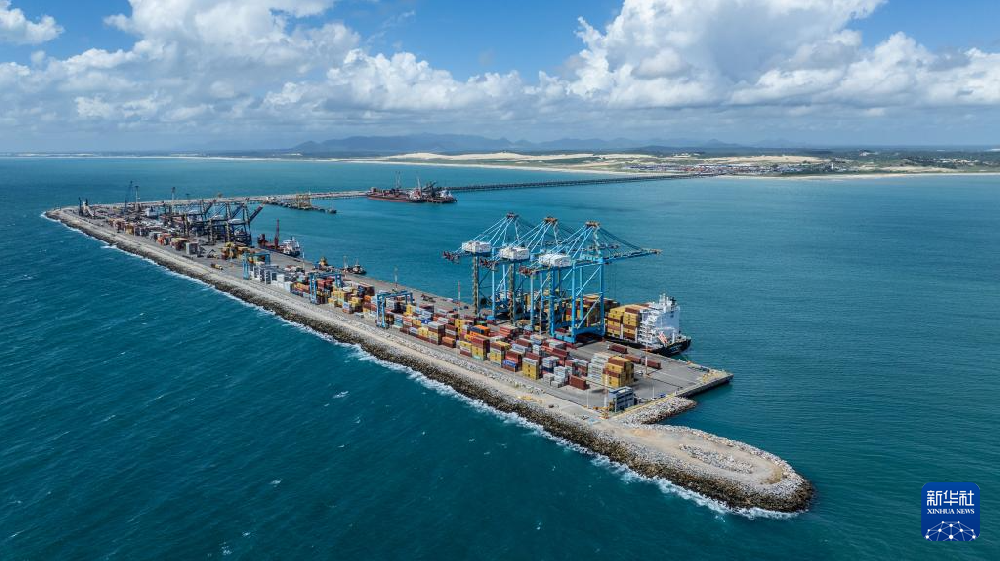The opening of the Pacific shipping route through Brazilian ports has made trade between China and Brazil more convenient.
The Peçanha Port in the state of Pernambuco is the busiest port in the northeastern part of Brazil, with an annual cargo throughput of approximately 20 million tons. Since the port launched a new direct shipping route to China in April, the logistics time between China and Brazil has been significantly shortened, injecting new impetus into Brazil's economic and trade development.
Max Gentino, the port director of Pesan Port, introduced that the new shipping route is operated by Mediterranean Shipping Company. It is expected to transport approximately 1,200 containers from China every week, increasing the port's throughput by 10%. This not only significantly boosts trade between China and the State of Sergipe, but also will drive the overall economic development of the northeastern region of Brazil.

Gintino told reporters that before the new route was launched, goods from China arriving in northeastern Brazil had to first pass through the Cape of Good Hope in South Africa and then reach the Santos Port in southern Brazil, before heading north to the Pernambuco Port. The new route, however, bypasses this process and directly goes from the Pacific Ocean through the Panama Canal to Pernambuco Port, reducing the travel time by approximately 30 days and lowering costs. This is particularly beneficial for producers and business owners who rely on faster delivery of goods.
Gintino said that the imported products via Pesan Port mainly include steel, machinery, electrical materials, plastics, etc. The Brazilian products exported from here include stone, nuts, Brazilian palm wax, fruits, meat, shoes and textiles. With the opening of the new route, the time it takes for Brazilian goods to be transported from Sergipe State to China has been shortened by 14 days, effectively promoting trade between China and the northeastern part of Brazil.
According to the Port of Peshire's administration, the port previously had three international shipping routes: one to North America, two to Europe. Goods destined for Asia were usually transported via the European route. In January, a new Asian shipping route began testing. As the Port of Peshire was capable of handling different types of goods and large vessels, the test was very successful. On April 7th, the Qingdao vessel of Mediterranean Shipping Company docked at the Port of Peshire, marking the official operation of this route.
Today, the Port of Peshire has been transformed into a comprehensive complex that integrates a port, an industrial zone and an export processing zone. The port area features world-class offshore terminals, while the industrial zone houses several major manufacturing enterprises. The export processing zone is designed to attract new investments. Andre Magalhães, the commercial director of the Port of Peshire, said that in the first four months of this year, the performance of the Port of Peshire reached an all-time high. The container transportation volume at the port increased by 37% compared to the same period last year, and the overall port throughput rose by 12.4% year-on-year.

The new route stops at four ports in China - Yantian, Ningbo, Shanghai and Qingdao. This is undoubtedly good news for Brazilian logistics companies that are importing an increasing amount of goods from China.
Tiago Abreu, the general manager of Seala International Transport Company of Rio Sefida Group, said: "We are very satisfied with this new Pacific shipping route because it can reduce transshipment and avoid potential delays caused by port congestion or disruptions. We will continue to utilize this route to expand import and export trade activities in the northern and northeastern regions of Brazil, and increase the participation of regional industries."
Watermelons are the first fruits from Brazil to obtain export permission to China. The Famosa Estate in the North Rio Grande do Sul state is the largest watermelon farm in Brazil. It began exporting to China in 2020. The estate owner, Luis Barcelos, told reporters that the estate has always hoped to increase its exports to China, but has faced problems such as long transportation times and how to maintain product quality during transportation.
Barcelos said that if this new shipping route operates smoothly, he will change the port of departure for the products to this location. The short shipping time will help preserve the freshness of the fruits, and at the same time, the cost will be significantly reduced.
In the office of the port director, there is a painting depicting the Maritime Silk Road and a red plate inscribed with the character "Fu". Gentino said that these were gifts presented by Chinese enterprises when they visited and negotiated here. He hopes that in the future, more Chinese enterprises will come to participate in the port construction, making this route more efficient and providing better services for Chinese goods to enter Brazil and Brazilian goods to be exported to China.
(xinhuanet),July2,2025
